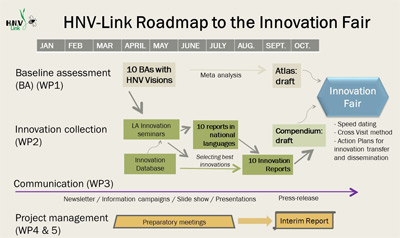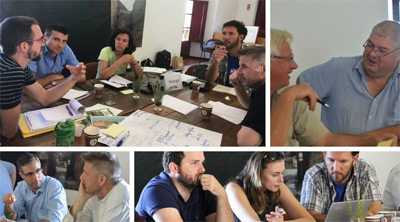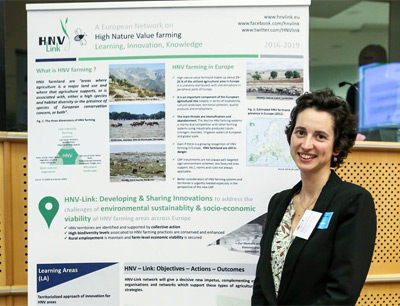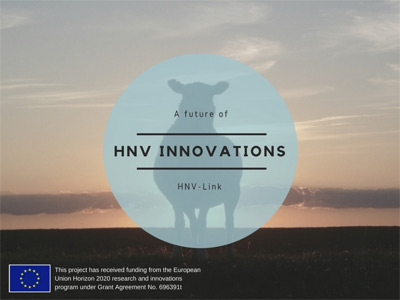HNV-Link Newsletter #3 (2017)

HNV-Link project aims to identify and share innovations that support farming systems in areas of high biodiversity across Europe. It supports efficient innovation transfer between its 10 Learning Areas.
Content:
- The High Nature Value farmland network in place
- From exploring to visioning
- HNV farmland visions born at national innovation seminars
- Key lessons from the Baseline Assessments
- Innovation Fair: trading ideas and expertise
- Work to follow
- High Nature Value Farming in education
- HNV-Link reaching out
- New project outputs on the website
- Many opportunities to get involved
The High Nature Value farmland network in place
The HNV-Link network currently consists of ten Learning Areas that are the first building blocks of an European-wide network promoting collaborative learning in High Nature Value farming areas. In this Newsletter, we illustrate how the process of shaping the HNV-Link network has proceeded from the Baseline Assessments and running Innovations seminars, to the first ever Innovation Fair for High Nature Value farming areas. We will also outline the next project steps and coming outputs.
From exploring to visioning

The HNV-Link thematic network works through an innovation brokering process through which High Nature Value Learning Areas are coordinated and stimulated through the project. The process seeks to gradually empower each Learning Area, building their capacity to lead innovation exchanges in order to tackle the specific challenges and needs identified, and by doing so to ensure the sustainability of HNV areas.
During the Shaping the network phase, each Learning Area team carried out its Baseline Assessment and, in a collaborative process, produced a vision for its HNV future. Each Learning Area then collected and documented existing innovations that improve the economic and social viability of the various areas without compromising their High Nature Values. The team also identified innovation needs in its Learning Area. This process involved key actors in a series of surveys and meetings, including an innovation seminar in each Learning Area (available here). This project phase culminated at the 2nd Network Meeting on 2-4 October in Montemor-O-Novo, Portugal, organised most succesfully by the University of Evora.
HNV farmland visions born at national innovation seminars

During the summer of 2017, each Learning Area (LA) team called together their stakeholders to debate a vision for their LA at multi-actor meetings which we called Innovation seminars. The HNV-Link project specifically aims to use the innovation process to start moving towards the HNV visions: building in the innovations that have been introduced so far, learning lessons from them and identifying innovation gaps. The Innovation seminars brought together the actors who will be key in creating a vibrant HNV farming area: farmers, administration, local authorities, producers associations, environmental and other NGOs and catalyzers, researchers, companies. At the meetings participants decided on which innovations need to be promoted in order to improve the socio-economic viability and environmental efficiency of the area in question.
Below are brief accounts of two Innovation seminars. The full reports in the national languages with the presentation for the stakeholders are available at the respective Learning Area pages. A compilation of all 10 innovation seminars (in respective languages) with an English summary is available here.
Bulgarian vision - Modernization that takes heritage into account
At a seminar on 2 June 2017, various actors in the Western Stara Planina Learning Area of Bulgaria acknowledged that agricultural production will inevitably modernize and the challenge thus is to preserve the ecological characteristics of the area. The participants also identified the most important innovative developments in the area, of which many depend on a stable and robust regulatory framework. There is a clear need to adapt the rules for CAP Pillar 1 support schemes to the needs of HNV farming, tailor the criteria of national coupled livestock breeding support schemes to the regional conditions, push for long-term contracts for the use of municipal grasslands and adjust the regulation of direct sales. To find out more about the meeting and the HNV vision drafted for the area, go here.
French HNV vision -agropastoralism at the heart of HNV farming
On the 13th of July 2017, some 20 agropastoralism actors gathered to review the innovations and innovation gaps related to pastoralism in the Causses and Cévennes, France. Many successful innovation examples were discussed at the event, chief among them being the Intercommunal Pastoral Agreement among breeders, researchers and elected representatives. To find out more about it, as well as the key obstacles to pastoralism in the area, go here.
Key lessons from the Baseline Assessments

The first part of the 2nd Network Meeting on 2-4 October in Montemor-O-Novo, Portugal, focused on the innovation process in the Learning Areas with their innovation assessments, each set in the context of their baseline situation and challenges. These allow the sharing and validating of the results and will enable a meta-analysis on the nature, success or failure, of innovation processes in the High Nature Value farmland to be prepared.
The key challenges of the Learning Areas vary widely as their context and experience. In these short videos, work package leader Xavier Poux from AScA introduces the Baseline Assessment rationale and Learning Area coordinators from Romania, Sweden and the UK share their thoughts on conducting the Baseline Assessments and creating HNV visions.
Baseline Assessments revealed several key points
- Innovation can spring itself once there is a favourable setting for it in the rural community, once the regulations and policy aids support it rather than stifle. Paying farmers for ecological results is one of the most promising approaches to date.
- Since taking up innovation often involves the risk of changing something which is familiar, they often arise out of crises of various types. Responding to crisis puts huge demand on everyone concerned, so the existence of a favourable support environment and mechanisms which encourage and support innovation are very important.
- Raising importance of High Nature Value farming in European context does not mean more public funding in the Common Agricultural Policy, which already spends 50 billion euros annually. About 40 % of the agricultural area in Europe is High Nature Value farmland. Is it not time for them to receive 40 % of the support funding?
- We should not neglect the importance of prevailing culture: in some regions innovators can be perceived as outliers and mistrusted in the tradition-bound rural culture.
- Farmers are not driven only by financial concerns but by the many linkages they have to their land. We should not neglect these linkages when using economic tools.
- Lifelong learning, both education and training, is key: in many countries, it is young people, who have received new kind of education outside their traditional context, who now are taking initiatives in their home communities and innovating. Elsewhere, education and training often promotes intensification and undervalues traditional skills.
- The role of individual animateurs cannot be overstated; supporting their work poses considerable challenges for policy.
- We need more people in HNV farming regions who are willing to light a candle in the dark rather than cursing the darkness.
Innovation Fair: trading ideas and expertise

The Innovation Fair for High Nature Value farmland areas took place at the 2nd Network meeting, 3rd October. From 140 innovation examples collected from the Learning Areas and regions around them, the Learning Area teams chose the most relevant sets of innovation to share with their local actors. All innovations will be assembled into an Innovation Compendium that will be freely available online. At the Fair, the Learning Area teams showcased the chosen examples (“offer lists”) and shared their most pressing needs for innovation (“wish lists”). In a speed-dating session, innovation “wish lists” and innovation “offer lists” were matched.
The Innovation Fair was a starting point for future collaboration between the Learning Areas and the match between wishes and offers will form a basis for the upcoming cross-visits. “The innovation fair was a truly positive experience which gave us a boost for our upcoming work in our learning area. When meeting face to face, as during the innovation fair, one can sense positive energy and motivation to solve problems and create ideas. This is because all the members of the network have a common goal; ecological, economical and social viability for HNV farming” says Lars Johansson from the Learning Area of Västra Götaland, Sweden. “After this face-to-face encounter, the threshold to get in touch and keep in touch is much lower and we look forward to seeing and hearing from our Pan-European friends in the future.”
Work to follow

The project has now entered its 3rd stage: Using and expanding the network. Designing Innovation Action Plans for all Learning Areas to adapt and transfer innovations from one Learning Area to another is one of the challenges at hand; dissemination activities in the region and Member State is another. At the networking meeting, each Learning Area received an hour of undivided attention from several other areas for identifying the best ways forward for some of their dissemination goals. Each Learning Area in HNV-Link has unique characteristics and, therefore, needs and capacities, while each partner bears unique experience and skills. Focusing on one situation at a time while pooling the wealth of expertises needs to be strong feature of European cooperation. There are no copy-and-paste solutions to sustaining Europe’s HNV farmland areas.
Some of the actions will involve organising cross-area visits to support in-depth learning from each other. During the field trip at the network meeting, the HNV-Link teams tested the methodology for such cross-visits proposed by another Horizon2020 project AgriSpin. It was a valuable departure point and the HNV-Link project will adapt it to its specific needs.
High Nature Value Farming in education

During the spring of 2017, the HNV-Link team conducted a survey which aimed to explore the extent to which the concept of High Nature Value farming is being utilized in higher and vocational education across Europe, to map the existence of educational resources relevant for the HNV farming topic, and to identify needs for specific educational materials. The survey was sent to over 300 educators and researchers across Europe from a variety of disciplines (agricultural, sustainable development and conservation biology studies). In total 62 people responded, whom the project sincerely thanks.
Responses to the survey are currently being used to develop the educational materials most requested: lecture slides and notes, thematic literature package, class and field assignments. The drafts will be circulated for comments and specific contributions requested during autumn 2017 and spring 2018. The final materials will carry the authorship attributions and will be available as open source resource.
Anyone who would like to contribute to this work or benefit from its outputs, can contact us
HNV-Link reaching out

Cooperation across the EU and regional projects is essential for increasing the impact of efforts from each project. Brief accounts of some of the meetings the HNV-Linkers co-organised or attended in 2017 can be found here:
Pastoral Territories- a meeting on extensive livestock and pastoralism in Zaragoza (27-28 th of March), co-organised by the HNV-Link partner in Spain, Entretantos. The minutes - an excellent summary of what was said and shared - are available here. Google Translate will help you if you are not fluent in Spanish.
Guy Beaufoy, EFNCP, presented the HNV-LINK project at a plenary of the European Grassland Federation. The presentation is available here.
Irina Herzon, University of Helsinki, gave a keynote talk at the 14th Eurasian Grassland Conference. The presentation and the meeting conclusions (inspired by HNV-Link story) are available from the event site.
Xavier Poux of AScA presented the initial results from the Baseline Assessments at a symposium "Reconciling agriculture and nature conservation across scales: challenges and opportunities for future social-ecological sustainability of high nature value farmlands" (European Association for Landscape Ecology). The abstract is available here.
The HNV-Link is closely following other relevant projects in Europe. The Life to Alvars project in Estonia (LIFE+) does impressive work on restoring thousands of hectares threatened alvars and spreading awareness through tourist firms, looking at possible labelling and creating necessary infrastructure. VivaGrass aims to support maintenance of biodiversity and ecosystem services provided by grasslands, through encouraging ecosystem based planning and economically viable grassland management.
New project outputs on the website

Several important project outputs are now available on the website:
- Assessment of the baseline situation. Guideline for coordinators
- Collection of Baseline Assessments
- A compilation of the innovation seminars (in the respective languages) with an English summary
- HNV farming SlideShow as a video and pdf - set of slides introducing some major features of High Nature Value farming
- Baseline Assessments - see under respective Learning Area
- Welcoming word from the project communication leader -a video
Many opportunities to get involved
- Inform us of an existing innovation example in your HNV farming area
- Inform us of a need for a specific innovation in your HNV farming area
- Download our outputs
- Follow us on social media and comment on the posts: Twitter, Facebook
- Subscribe to the newsletter here
We are at www.hnvlink.eu.
Contact us:
Back to news overview
